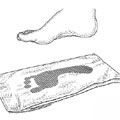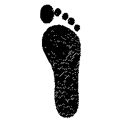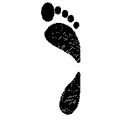Running Shoes Fitting Guide
One of the most challenging aspects to getting running shoes is not what brand to get, but what type of running shoe to get. There are a number of factors that go into that decision. Two of the main questions should be what type of arch do I have and what type of running shoe do I need, cushioning, stability or motion control? Below you will see how to get a look at what type of arch you have and the different types of running shoes. Also, the following link is a PDF that was created by Rogan's Shoes to help you compare the different types of running shoes across brands. Click on this link to see the guide - Rogans Best Fit Running Guide.
(1) Pour a thin layer of water in a shallow pan. (2) Wet the sole of your foot in the pan. (3) Step onto a shopping bag or a piece of heavy paper. (4) Step off and look down at the mark on the bag or paper.

If you see about half of your arch, you have the most common foot type and are considered a normal pronator. Contrary to popular belief, pronation is a good thing. When the arch collapses inward, this "pronation" absorbs shock. As a normal pronator, you can wear just about any shoe, but may be best suited to a stability shoe that provides moderate arch support (or medial stability). Lightweight runners with normal arches may prefer neutral-cushioned shoes without any added support.

If you see almost your entire footprint, you have a flat foot, which means you're probably an overpronator. That is, a micro-second after your foot strikes the ground, your arch collapses inward too much, resulting in excessive foot motion and increasing your risk of injuries. You need either stability shoes, which employ devices such as dual-density midsoles and supportive "posts" to reduce pronation and are best for mild to moderate overpronators, or motion-control shoes, which have firmer support devices and are best for severe overpronators, as well as runners that weigh over 165 pounds, or tall or bow-legged runners.

If you see just your heel, the ball of your foot, and a thin line on the outside of your foot, you have a high arch, the least common foot type. This means you're likely an underpronator, or supinator, which can result in too much shock traveling up your legs, since your arch doesn't collapse enough to absorb the shock of your foot hitting the ground. Underpronators are best suited to neutral-cushioned shoes because they need a softer midsole to encourage pronation. It's vital that an underpronator's shoes have no added stability devices to reduce or control pronation (those devices are in stability or motion-control shoes.

Shoe Types:
Cushioning Shoes (neutral)
A Neutral Cushioning shoe is best for runners with a high arch who do not pronate effectively. These shoes do not have medial supports but are more concerned with midsole cushioning. The midsole will provide the extra shock absorption that the underpronator needs. Neutral Cushioned shoes also work well for midfoot and forefoot strikers.
Stability Shoes
Stability shoes are for runners who have normal or medium arches who are mild to moderate overpronators. These shoes have some medial support and good midsole cushioning. Because normal or medium arches are the most common foot type, most runners will need Stability shoes.
Motion Control Shoes
Motion Control shoes are for runners who generally have a low or flat arch and are moderate to severe overpronators. These shoes employ extra support devices on the medial side to slow excessive pronation and tend to have wider and flatter outsoles. Heavier runners who need extra support and durability may also want Motion Control shoes.
Trail Shoes
Trail shoes are for runners who desire better traction and durability for off-road runs. These shoes tend to be more weather and water resistant. They also have a little stiffer construction for better stability on uneven terrain. Trail shoes can be neutral, motion control or stability shoes. There are trail shoes for men, women and kids.
Running Shoe Guide
Click on the link to see Rogan's Shoes Best Fit Running Guide for reference. Rogans Shoes Best Fit Running Guide.
More Tips:
Focus on the ride. Once you know the type of shoe you need, whether motion-control or stability, then you need to be sure there is no pinching, or a seam that is pressing against your foot. Finally, we recommend people run or walk in the shoe on a clean indoor surface and really focus on the ride, or how the shoe feels from the point when the heel hits the ground to when the toe lifts off the ground
Line up the ball. When you try your shoe on, the ball of your foot (the widest part) should line up exactly with the widest part of the shoe. If that fit is right, the entire foot should line up from the toes to the heel. As for width, when you're standing in the shoe, your foot should rest gently against the sides of the shoe, rather than jamming up against the sides or not touching the sides at all. Also, be sure your toes aren't being pinched from the side. Room in the toe box is essential to a good fitting running shoe. Too many people fit their running shoes too SMALL!
Do not go by your regular size! Running shoes tend to fit small. Some brands can be small in length by a size or more. If ordering online, feel free to give us a call and ask how the shoe fits.
If you have any questions about fit please call us at 1-800-976-4267 and we will gladly assist you with sizing your shoes.
Check out our selection of name brand running shoes for the entire family:




 Safety Footwear
Safety Footwear 




